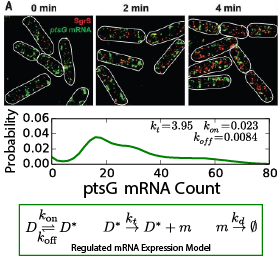C&S10: Small RNA Regulation in E. coli

A high level of gene regulation is achieved by regulatory RNAs that can modulate mRNA translation independently from transcriptional signals. This principle is not only crucial to complete the picture of gene regulation; it also forms the basis of small interfering RNA therapies that are under development to treat a host of diseases, including several types of cancer. Variants of regulatory RNA exist in all domains of life and are known in bacteria as small RNA (sRNA). Seminal single-molecule imaging studies have yielded insight into the in vivo action of the E. coli sRNA SgrS (sugar-transport related sRNA), which regulates sugar uptake by its selective recognition and the thereby triggered degradation of the mRNAs for ptsG and manX (which encode the primary glucose and mannose transporters in E. coli). In this collaboration, Center-developed whole-cell simulation technologies incorporated in Lattice Microbes (LM) are used to investigate (1) the role of spatial localization on SgrS-mRNA binding kinetics and competition and (2) the downstream effects of SgrS control of sugar uptake on cellular metabolism.
The first task is to rationalize the experimentally observed SgrS-mRNA binding kinetics. This task requires whole-cell simulation methods which account for the spatial distributions and low copy numbers of the involved species, and which can describe RNA search and binding processes within an entire E. coli cell. The simulations are achieved by Reaction-Diffusion Master Equation (RDME) calculations with LM (TRD3). The second task arises from extracting model parameters from experimental data and feeding them into the RDME simulations, which will be possible with the Exp-2-LM interface (TRD3). Some latest experiments called SortSeq are also yielding information about importance of individual bases on SgrS sequence in its regulatory role. The third task lies in the investigation of the downstream effects of SgrS regulation of sugar transporter expression on the overall metabolic network, which are not accessible to experiment. Population flux balance analysis (popFBA) techniques, together with simulations coupling stochastic processes to steady-state metabolic descriptions (TRD3), will allow us to study these effects computationally.
This work builds upon the Center's long-standing collaboration with Ha and the more recent collaboration with Fei. Recently, Ha and Fei developed a single-molecule super-resolution imaging platform to study the copy number distributions and localization of SgrS, the ptsG and manX mRNAs, and their complexes. It was found that SgrS is largely distributed within the cytoplasm while the ptsG and manX mRNAs predominantly localize to the membrane. Surprisingly, the search kinetics of SgrS and the mRNAs were slower than simple diffusion arguments would suggest. These experiments laid the foundation for modeling mRNA transcription and degradation dynamics; the data on ptsG mRNA expression was already used in modeling the impact of DNA replication on mRNA expression noise. SortSeq experiments and collaborative analysis of data to look at role of individual bases in regulatory activity of SgrS looks promising. We able to identify regions involved in base pairing with target sequence and also regions binding to Hfq protein to carry out the actual regulatory role.
Modeling SgrS regulation of ptsG and manX expression will involve constructing spatially- resolved stochastic models that explicitly incorporate further localization data from super-resolution imaging, specifically smFISH (single-molecule fluorescence in situ hybridization) (Fei). Sort-seq experiments (Ha) will allow the derivation of kinetic parameters for SgrS-mRNA binding and unbinding. These spatially-resolved stochastic models will help to explain the observed slower-than-expected SgrS-mRNA search kinetics as well as lend insight into competition of the mRNAs for an sRNA binding partner. SortSeq experiments are also yeilding predictions about mutations on the SgrS sequence which will have most effect on its regulatory activity and hence helping us to design mutant library to confirm the predictions experimentally. The work will then be extended to investigate the global effects of SgrS regulation on metabolism. We will employ population FBA and coupled LM-FBA simulations (TRD3) in order to study how stochasticity in ptsG expression affects glucose utilization and energy metabolism in individual E. coli cells, as well as any possible effects related to other here-to-fore unknown SgrS targets.



